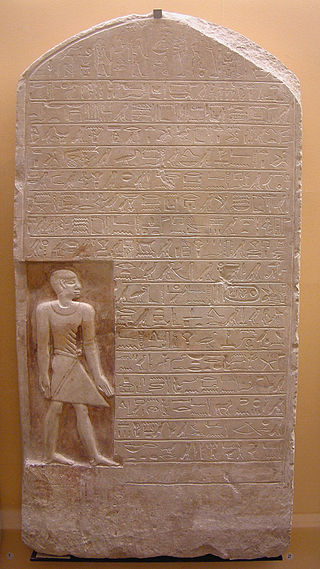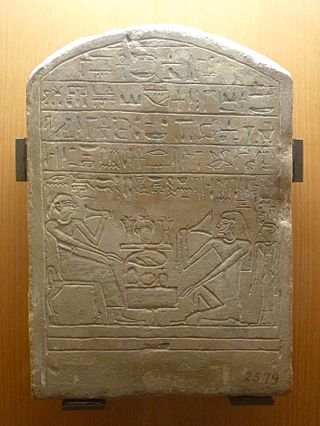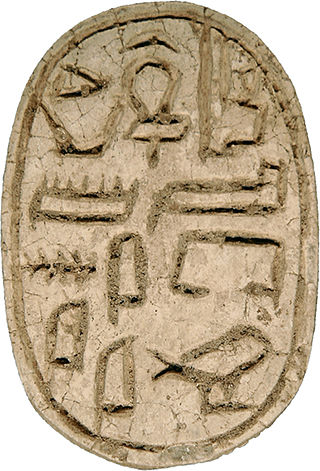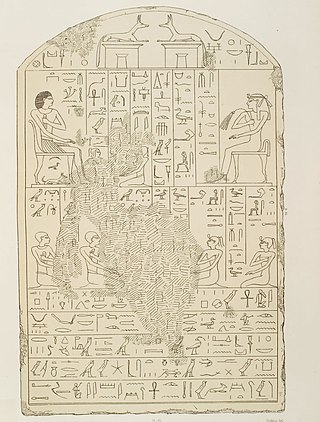
Userkare Khendjer was a minor king of the early Thirteenth Dynasty of Egypt during the Middle Kingdom. Khendjer possibly reigned for four to five years, archaeological attestations show that he was on the throne for at least three or four years three months and five days. Khendjer had a small pyramid built for himself in Saqqara and it is therefore likely that his capital was in Memphis.

Senakhtenre Ahmose, was a king of the Seventeenth Dynasty of Egypt during the Second Intermediate Period. Senakhtenre reigned for a short period over the Theban region in Upper Egypt at a time where the Hyksos 15th Dynasty ruled Lower Egypt. Senakhtenre died c.1560 or 1558 BC at the latest.

Sehetepkare Intef was the a minor king of the early 13th Dynasty during the late Middle Kingdom.

Khaneferre Sobekhotep IV was one of the more powerful Egyptian kings of the 13th Dynasty, who reigned at least eight years. His brothers, Neferhotep I and Sihathor, were his predecessors on the throne, the latter having only ruled as coregent for a few months.

Neferuptah or Ptahneferu was a daughter of the Egyptian king Amenemhat III of the 12th Dynasty. Her sister was the Pharaoh Sobekneferu.

Merhotepre Ini was the successor of Merneferre Ay, possibly his son, and the thirty-third king of the Thirteenth Dynasty of Egypt. He is assigned a brief reign of 2 Years, 3 or 4 Months and 9 days in the Turin Canon and lived during the early 17th century BC.

Sobekhotep III was an Egyptian king of the mid Thirteenth Dynasty of Egypt who reigned three to four years.

Ankhu was an Egyptian vizier during the early 13th Dynasty in the late Middle Kingdom. He is believed to have resided in Thebes in Upper Egypt.

Iymeru Neferkare was the ancient Egyptian vizier under king Sobekhotep IV in the 13th Dynasty, in the Second Intermediate Period.

Aya was an ancient Egyptian king's wife of the early Thirteenth Dynasty.
The Papyrus Boulaq 18 is an ancient Egyptian administrative document. It contains an account of the Theban palace dating to the 13th Dynasty. The papyrus lists the palace officials and the rations they received day by day. Important officials mentioned are, for example, the vizier Ankhu, but also the queen Aya. Therefore, the document is of great historical importance. It also reports the journey of the king to the temple at Medamud and reports the arrival of a delegation of Nubians.

Senewosret-Ankh {s-n-wsrt-ꜥnḫ/snfrw} was an ancient Egyptian vizier of the Middle Kingdom, dating to the end of the Twelfth or to the beginning of the Thirteenth Dynasty.

Sekhemre Sementawy Djehuty was a minor king reigning over parts of Upper Egypt during the Second Intermediate Period.
This page list topics related to ancient Egypt.

Ameny was an ancient Egyptian official of the 13th Dynasty with the title high steward. In this function he was the main administrator of the royal estates.

Seth Meribre was a little known king during the 13th Dynasty.

The Abydos Dynasty is hypothesized to have been a short-lived local dynasty ruling over parts of Middle and Upper Egypt during the Second Intermediate Period in Ancient Egypt. The Abydos Dynasty would have been contemporaneous with the Fifteenth and Sixteenth Dynasties, from approximately 1650 to 1600 BC. It would have been based in or around Abydos and its royal necropolis might have been located at the foot of the Mountain of Anubis, a hill resembling a pyramid in the Abydene desert, close to a rock-cut tomb built for pharaoh Senusret III.

Hatshepsut was an ancient Egyptian king's daughter of the 13th Dynasty, around 1750 BC. There are three instances where a person named Hatshepsut is mentioned. It is not known if these are the same or different individuals.
Resseneb was a short-lived vizier in Upper Egypt during the 13th Dynasty, preceded by his father, the famous Ankhu, and succeeded by his brother Iymeru.

Amenyseneb was the Controller of a Phyle or Regulator of a Watch at Abydos during the early 13th Dynasty in the late Middle Kingdom. While he was an official of lower rank, his attestations binds important persons like king Khendjer and vizier Ankhu in time.

















